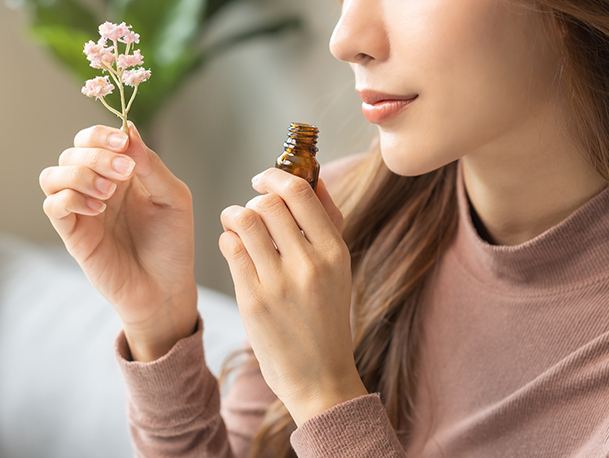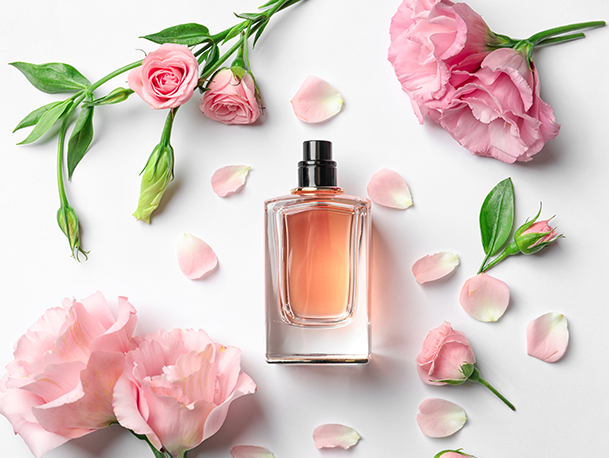Estimated Reading Time: 5 minutes
- A Review of Essential Oil Notes
- Different Scent Families
- Commonly Used Scents in Perfumery
- Tips for Creating Your Own Perfumes
- Key Takeaways
- Contraindications for Essential Oils
Scent has a powerful way of pulling an outfit together and leaving an impression when we walk into any room. For centuries, people have been wearing fragrances to express their unique personality and style. Natural aromatic oils and absolutes such as Rose and Jasmine were used to create exotic perfumes and colognes, and many of these ingredients are cemented in today’s perfumery industry. Chanel, Dior, Tom Ford, and Marc Jacobs have used perfume scents inspired by nature to create iconic fragrances that have garnered a cult following.
Finding your signature scent can be a long process. However, knowing the most common perfume oils, as well as the different scent notes and fragrance families can help you narrow down which scents you are drawn to. You can also get creative and blend your own personalized fragrance with a handful of essential oils. Continue reading to discover the anatomy of the most popular perfume scents on the market, the different aromatic categories they belong to, and how to replicate your favorite scents to create your own unique signature scent.
A REVIEW OF ESSENTIAL OIL NOTES
Every aromatic oil can be categorized as a top note, a middle note, or a base note.

Top notes are the first scents you will notice when you smell a fragrance and are the quickest to evaporate. Top notes are typically sharper in scent and only require a few drops in a perfume blend. Spice oils such as Pepper Black and Citrus oils such as Bergamot are examples of top notes.
Middle notes are softer and last longer than top notes and are less apparent than base notes. In a fragrance blend, middle notes help to round out their respective top and base notes. Clary Sage, Lavender, and Rosemary are examples of middle notes.
Base notes create the foundation for a long-lasting, rich fragrance. They are rich, intense, and grounding in nature. Jasmine, Vetiver, Patchouli, and Vanilla are effective base notes that are preferred by perfume formulators.
To learn more about essential oil notes and how they interact with one another, read our blog about Essential Oil Diffuser Blends.
UNDERSTANDING THE DIFFERENT SCENT FAMILIES
Before choosing your signature fragrance, it is important to know the four main scent families. Identifying the different perfume scents and which scent families they belong to will help you determine what you like most about your favorite fragrances. Aromatic oils such as essential oils and absolutes fall into one of four scent categories: fresh, floral, oriental, and woody.
Fresh fragrances are invigorating, zesty, and vibrant, and are typically associated with citrus scents, green notes, and cool undertones including sea spray. Fresh fragrances can be citrus based, featuring notes of Bergamot, Lemon, and Grapefruit, or herbal and earthy, blending scents such as Patchouli, Rosemary, and Basil.
One of the most recognizable scent profiles in perfumery, floral fragrances feature sweet and flowery notes. Rose and Jasmine Absolutes are the cornerstones of this category, although Ylang Ylang and Lavender are also popular in floral fragrances.
Oriental fragrances possess a distinctive warmth, as well as a subtly spicy yet sweet quality. These luxurious perfumes and colognes can be further categorized into floral oriental, soft oriental, and woody oriental scents. Notes of Cardamom, Cinnamon Bark, and Vanilla are commonly used to add dimension and sensuality to oriental fragrances, while the exquisite scent of Jasmine Absolute rounds out these unique aroma notes.
Another warm scent profile, woody fragrances are mysterious and alluring. Typically associated with nighttime wear, woody fragrances are preferred in aftershave formulas. Cedarwood, Sandalwood, Vetiver, and Amber are keystone scents that make up this scent profile. Woody fragrances can be divided into two subcategories: mossy woods that possess earthy and sweet accents, and dry woods that smell smoky and leathery.
THE MOST COMMONLY USED SCENTS IN PERFUMERY
Bergamot Essential Oil – Extracted from the fruit of the Bergamot tree grown in Italy, this citrusy scent is a cross between the Orange and the Citrus limetta (a species of Citrus regarded as “Sweet Lemons” or “Sweet Limes”). Bergamot is a popular essential oil in aromatherapy and perfumery due to its tangy, brilliant aroma that creates a refreshing and uplifting effect.
Pepper Black Essential Oil – Commonly a top note, Pepper Black pairs best with spicy and slightly woody scents to add a complexity that is sultry and luxurious. Due to its sharp nature, Pepper Black is blended with a light hand and only requires a small amount to make a lasting impact.
Clary Sage Essential Oil – Known for its herbaceous scent that is balanced by sweet, floral notes, Clary Sage acts as a middle note of medium aroma and adds an unexpected fresh quality when used in fragrances. This earthy and invigorating aroma creates an androgynous scent that is ideal for use in gender-neutral perfumes and colognes, namely Banana Republic Slate, Versace Pour Homme, and Chanel Antaeus. Clary Sage also possesses musky notes that are reminiscent of amber and tobacco.
Vanilla – One of the most popular perfume scents, Vanilla is easily recognizable for its sweet, decadent, and rich. Acting as a base note in fragrance formulation, Vanilla’s creamy and warm aroma blends well with an array of other aromas, namely incense, woody, and oriental scents. Possessing an exquisite versatility, Vanilla can be blended into a perfume to add sweetness, depth, and warmth, as well as smooth out any rough edges. Vanilla is featured in famous fragrances including Un Bois Vanille by Serge Lutens, Tom Ford’s Tobacco Vanille, Yves Saint Laurent Black Opium, Prada Candy Kiss, Lord of Misrule by Lush, and Chanel Coco Noir.
Patchouli Essential Oil – Extracted from the fragrant Pogostemon cablin herb grown in Malaysia and India, Patchouli is a strong, herbaceous base note that is balanced by musky, earthy, and balsamic accents. Patchouli is a staple in fragrances that are oriental, earthy, and fougère in nature. This mossy, sharp scent has been used in perfumery for centuries, and is most prominent in fragrances including Le Labo’s Patchouli 24, Chanel’s Coromandel, Tom Ford’s White Patchouli, and Lush’s Lord of Misrule.
Jasmine Absolute – Regarded as the “King of Perfumery”, Jasmine Absolute is highly desired by formulators due to its complex aroma that is sweet, intensely floral, and balanced by musky-animalistic undertones. Acting as a middle note, Jasmine has the ability to balance out a fragrance blend while adding an irresistibly romantic aura. The two main species used to make Jasmine Absolute include the day blooming and feminine Royal Jasmine (Jasminum grandiflorum), and the night blooming, muskier, more masculine Arabian Jasmine (Jasminum sambac). Jasmine’s full-bodied aroma is featured in the ever-famous Chanel No. 5, as well as in Dior Eau Sauvage, J’Adore Dior, Femme by Rochas, Viktor & Rolf Flowerbomb, Oscar Jasmine by Oscar de la Renta, and Glam Jasmine by Michael Kors.
Rose Absolute (Bulgaria) – Another staple in modern perfumery, Rose Absolute is hailed as the “Queen of Fragrance” for its delicate yet rich, intricate aroma that closely resembles the scent of true rose. Having been distilled in Bulgaria for over 300 years, almost 4000 kilograms of rose petals are required to produce 1 kilogram of pure rose oil. While it is one of the most expensive ingredients in perfumery, its exquisite quality allows a small amount to go a long way, allowing formulators to get the most out of their investment. Rose Absolute is featured in an array of classic and cult-favorite fragrances, including Chanel No. 5, Chanel Coco Mademoiselle, Dior Miss Dior Rose N’Roses, Tom Ford Rose Prick, Marc Jacobs Daisy Eau So Fresh, Rose Jam by Lush, and Chloe Roses de Chloe.

TIPS FOR CREATING YOUR OWN PERFUMES
If you choose to blend your personal perfume according to note, keep in mind that the top note will be the first scent you notice upon application, and is the quickest to evaporate. Over time, the middle note will become more prominent, and finally, the base note will be the last scent that you smell. It is also worth noting that your essential oil perfume will interact with your personal chemistry, which will also cause the aroma to change the longer you wear it.
Typically, a 1:1:1 ratio between the top, middle and base notes is recommended when blending your own perfume. For a sharper fragrance, you can blend a ratio of up to 4:2:1.
Begin by placing one drop of your base note of choice into a dark amber glass bottle. Be sure to smell the aroma at each stage of blending. Next, add the middle note and swirl the mixture to blend it evenly. Then, add one drop of the top note and swirl to blend. Smell the mixture, and feel free to add up to two more drops of each of the oils until you reach your desired scent.
To make the fragrance last longer, consider mixing the essential oils with a stable vegetable oil, such as Jojoba, as the base.
KEY TAKEAWAYS
- Fragrance Categories: Perfume scents are classified into several categories, including floral, oriental, woody, and fresh, each evoking different emotions and moods.
- Fragrance Pyramid: Perfumes are structured using a “fragrance pyramid” consisting of top notes, middle (heart) notes, and base notes. Each layer interacts to create a unique scent experience.
- Popular Scents:
- Floral: Common in feminine fragrances, featuring rose, jasmine, and lily.
- Woody: Known for grounding and earthy scents, including sandalwood and cedar.
- Oriental: Warm and spicy, often using ingredients like vanilla, amber, and cinnamon.
- Fresh: Light and clean, characterized by citrus, aquatic, and green notes.
- Fragrance Preferences: Personal fragrance preferences are influenced by individual tastes, emotions, and memories associated with certain scents.
CONTRAINDICATIONS FOR ESSENTIAL OILS
All New Directions Aromatics Essential Oils and Absolute Oils are for external use only. They should not be ingested and should not be stored within the reach of children, in case of accidental ingestion. As with essential and carrier oils, a patch test should be conducted on the inner arm or another generally insensitive area of skin, using a dime-size amount of the specified oil to check for sensitivities. An absence of an allergic response within 48 hours suggests that the oil is safe to use.
With responsible use and proper dilution, the topical application of most Essential Oils and Absolute Oils are generally known to be safe. However, irritations, allergies, rashes, and other side effects are possible. In the chance of an allergic reaction, discontinue use of the product and see a doctor, pharmacist, or allergist immediately for a health assessment and appropriate remedial action. To prevent side effects, consult with a medical professional prior to use.
Essential or carrier oils must never be used near the eyes, inner nose, and ears, or on any other particularly sensitive areas of skin.
